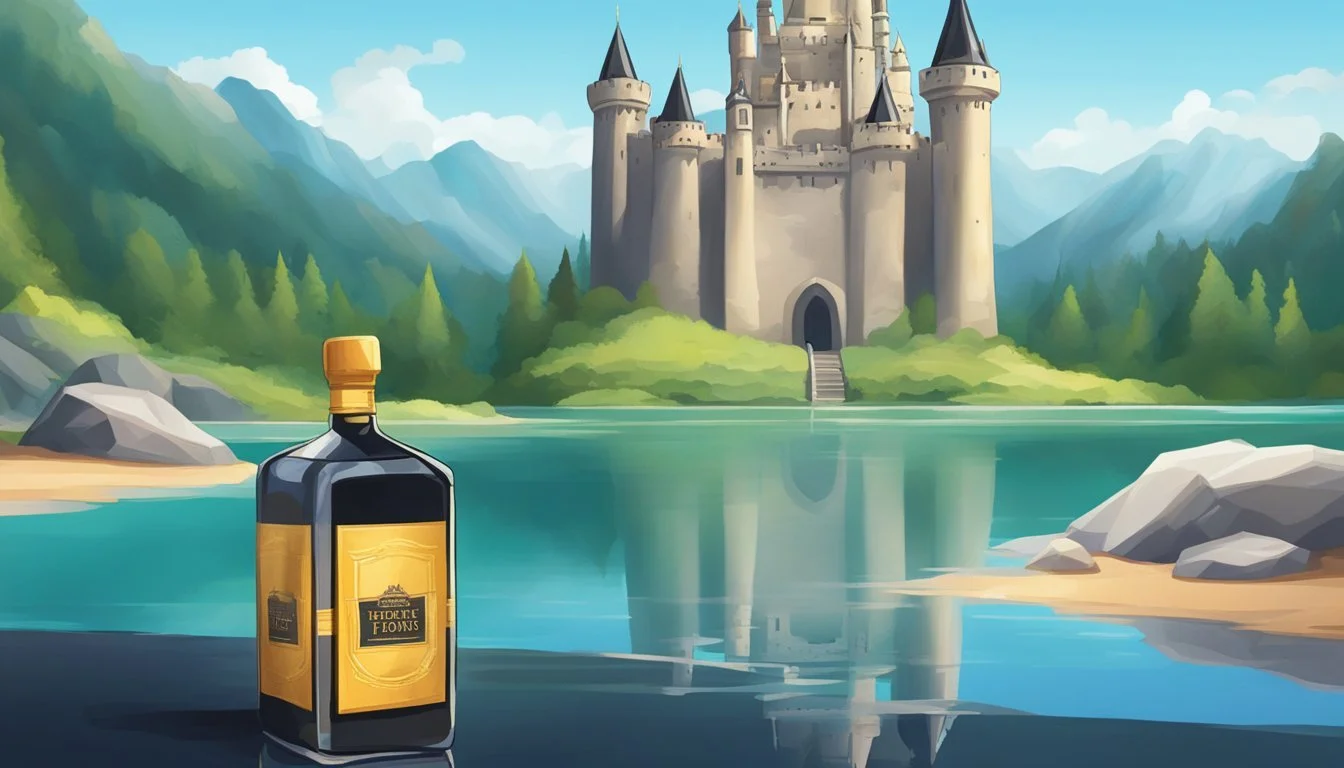Castle Rock vs. Blk
Analyzing the Best Bottled Water
When it comes to selecting the best bottled water, discerning consumers often face a challenging decision. Two brands that frequently come up in discussions are Castle Rock and blk. water. Each brand offers a distinct experience with its own set of benefits, making the choice not a straightforward one.
Castle Rock water is celebrated for its crisp flavor, reminiscent of a fresh morning hike in the mountains. Its subtle and clean taste ensures that there's no lingering aftertaste, which many find refreshing. In contrast, blk. water stands out with its deep obsidian hue and unique infusion of fulvic trace minerals, which some believe offer potential health benefits. This black water challenges traditional expectations with its striking appearance and distinctive properties.
For those prioritizing a pure and classic taste, Castle Rock emerges as a strong contender. Meanwhile, blk. water appeals to those looking for an innovative hydration option with added health claims. The decision boils down to personal preference and specific hydration goals, making it essential to weigh the attributes of each brand.
Understanding Bottled Water
Bottled water varies greatly in its source, treatment, and mineral content. This section explores definitions, types, popular brands, and governing regulations for bottled water.
Defining Bottled Water
Bottled water is water packaged in bottles for human consumption. It can originate from various sources, including springs, wells, and municipal supplies. The water undergoes processes to remove impurities and may be enhanced with minerals. Key types include spring water and purified water.
Spring water is sourced from natural springs and retains its natural mineral content. Purified water, on the other hand, is often municipal water that has been treated to remove contaminants. Reverse osmosis and distillation are common methods of purification.
Types of Bottled Water
Bottled water varies not just by source but also by treatment and added substances.
Spring Water: Natural and rich in minerals.
Purified Water: Processed to remove impurities; examples include reverse osmosis and distilled water.
Mineral Water: Contains specific levels of minerals and is usually sourced from springs.
Sparkling Water: Carbonated water, can be naturally effervescent or have added carbonation.
Alkaline Water: Has a higher pH level, often claimed to offer health benefits.
Still Water: Plain water without carbonation.
Bottled Water Brands
Several brands dominate the bottled water market, each with unique characteristics:
Castle Rock: Known for its eco-friendly glass bottles and naturally purified spring water.
blk.: Distinctive for its black color, contains fulvic trace minerals.
Evian: Premium brand, sourced from the French Alps with a balanced mineral content.
Aquafina: Purified water sourced from municipal supplies, goes through a thorough purification process.
Dasani: Coca-Cola’s water brand, generally similar to Aquafina in treatment.
Smartwater: Vapor-distilled water with added electrolytes.
Different brands not only vary in taste but also in mineral content and purity levels.
Regulations and Standards
Bottled water is subject to regulations to ensure safety and quality.
In the USA, the Food and Drug Administration (FDA) oversees bottled water, ensuring it meets safety standards.
The Environmental Protection Agency (EPA) regulates tap water, but bottled water must meet the same or higher standards.
Labeling requirements mandate that the source and type of water are clearly indicated on the bottle.
These regulations help maintain the safety and quality of bottled water across different brands and types, ensuring consumer confidence.
Comparing Castle Rock and BLK Water
When choosing between Castle Rock and BLK Water, it is important to consider their source, filtration methods, nutrient content, and flavor profiles to determine which one meets your hydration needs and preferences.
Source and Origin
Castle Rock Water is sourced from a natural spring located in the Shasta region of California. This spring water is renowned for its natural purification process, which includes cycles from ocean, to rain, to glacier, and ultimately, to the spring.
In contrast, BLK Water originates from various groundwater sources across Canada and the United States. Its unique feature is the infusion of fulvic acid, giving it a distinct black color and potentially offering additional health benefits.
Filtration and Purity
Castle Rock undergoes a natural filtration process as it travels through the layers of the earth, which helps to naturally purify the water. This method does not involve artificial filtration techniques but relies heavily on natural geology for cleanliness.
BLK Water, on the other hand, goes through extensive filtration, including processes like reverse osmosis to ensure purity. The incorporation of fulvic acid, which is believed to have detoxifying properties, is a key aspect of its filtration process, making it a unique choice for health-conscious consumers.
Nutrients and Mineral Content
Castle Rock water boasts a balanced composition of essential minerals such as calcium, magnesium, potassium, and low levels of sodium. It provides a good source of electrolytes, making it an ideal choice for hydration.
BLK Water's distinct feature is its high fulvic acid content, which is thought to enhance nutrient absorption and provide trace minerals often missing in regular diets. It may not have an extensive mineral profile like Castle Rock but is marketed for its potential health benefits due to its unique composition.
Mineral Castle Rock BLK Water Calcium High Moderate Magnesium Moderate Low Potassium Low Trace amounts Sodium Trace amounts Trace amounts Fulvic Acid None High
Taste and Flavor Profiles
Castle Rock water is often described as having a crisp and clean taste, akin to a fresh mountain spring. It has a smooth mouthfeel with no detectable aftertaste, making it a favorite for those who prefer a traditional water flavor.
BLK Water, due to its fulvic acid content, has a slightly earthy taste that may be unfamiliar to first-time drinkers. Despite its dark color, many users report that it tastes very much like regular water, though the unique appearance can be off-putting to some.
By considering these factors, you can better understand the distinctive characteristics of Castle Rock and BLK Water, aiding in making an informed decision on which one is better suited for your preferences and needs.
Health and Hydration
Comparing Castle Rock and Blk bottled water, this section will examine their impact on hydration and potential health benefits. Focus will be on hydration properties, PH levels, and the presence of electrolytes.
Hydration Benefits
Castle Rock and Blk both offer unique benefits for maintaining hydration. Castle Rock is known for its natural spring water origin, which includes essential minerals that are beneficial for hydration. Blk water, meanwhile, is marketed for its high pH level, typically around 8-9, which some claim enhances hydration, despite scientific evidence not fully supporting this.
Electrolytes present in both brands contribute significantly to their hydration capabilities. Blk water contains added electrolytes like magnesium, sodium, and potassium, which can improve water absorption and fluid balance in the body. Castle Rock may have naturally occurring electrolytes, depending on its source. These differences could influence your choice based on individual hydration needs and preferences.
Potential Health Effects
The health implications of consuming Castle Rock and Blk extend beyond just hydration. Blk water’s high pH levels suggest an alkaline composition, which some research associates with potential health benefits such as improved gut health and potentially better sleep quality. However, it’s worth noting that the body's own pH balance mechanisms usually negate significant benefits from alkaline water.
Castle Rock's natural spring water might appeal to those concerned about heavy metals and contaminants. Spring water is often perceived as having fewer pollutants compared to processed water, reducing exposure to toxins like lead. Ensuring quality and purity standards, Castle Rock offers reassurance to health-conscious consumers. Blk, while generally safe, doesn’t emphasize natural sourcing, which might be a consideration for some.
Both brands provide unique health benefits, making them suitable for different health and hydration considerations.
Environmental Impact
Both Castle Rock and Blk aim to position themselves as environmentally friendly options in the bottled water market. Their efforts include utilizing eco-friendly packaging and promoting sustainability initiatives.
Eco-Friendly Initiatives
Castle Rock has implemented several initiatives to reduce its environmental footprint. They primarily use glass bottles, which are not only recyclable but also reduce plastic waste. Additionally, they have partnered with reforestation projects to offset carbon emissions. This dual approach helps to mitigate their overall environmental impact.
Blk, on the other hand, uses PET plastic bottles, which are recyclable but less eco-friendly than glass. They focus on reducing plastic usage by creating lightweight bottles and encouraging recycling among consumers. While these steps are valuable, the reliance on plastic remains a significant environmental challenge.
Bottled Water and Sustainability
The production of bottled water has considerable environmental consequences. Studies show that bottled water production releases significant amounts of CO2, with quantities ranging from 1.6 to 22 oz per 50 oz of water. This carbon footprint is substantially higher than that of tap water.
For example, if the entire population of a city like Barcelona switched to bottled water, it could result in the loss of up to 1.43 species per year and cost an additional $83.9 million. The resource extraction for bottled water production is also 3,500 times higher than that of tap water, placing a severe strain on natural resources and ecosystems.
Consumer Considerations
When choosing between Castle Rock and Blk bottled water, it's essential to consider factors such as ease of purchase and cost implications. The following analysis focuses on these aspects to help consumers make informed decisions.
Accessibility and Convenience
Castle Rock and Blk bottled waters are available at various grocery stores across the United States. Castle Rock is known for its glass bottles, which attract environmentally conscious consumers. Blk water is unique due to its distinct black color derived from fulvic acid, making it a trendy choice.
Castle Rock may be harder to find due to its niche market positioning, mostly available in specialized stores and eco-friendly shops. Blk water, capitalizing on its popularity, is more readily available in mainstream grocery stores, making it a convenient option for many.
Online purchasing is an option for both brands, often providing discounts and bulk buying options. Consumers who prioritize eco-friendly packaging and premium sourcing might lean towards Castle Rock, while those emphasizing ease of access and trendiness might prefer Blk.
Cost Analysis
Cost is a significant factor when deciding between Castle Rock and Blk bottled water. Castle Rock, with its premium branding and glass bottles, generally comes at a higher price point. The use of glass not only increases production costs but also adds a level of perceived value.
Blk water, despite its unique selling point of being infused with fulvic acid, is competitively priced. It is often cheaper than Castle Rock, particularly due to its plastic packaging, which lowers production and transportation costs.
Consumers who prioritize environmentally friendly packaging might justify the higher cost of Castle Rock. Conversely, those looking for an economical but stylish option might find Blk more attractive.
The cost differences highlight the brands' varying appeals, with Castle Rock appealing to the premium segment and Blk catering to a broader audience.
Expert Insights
Experts in the field of water tasting provide unique perspectives on Castle Rock and blk. water, considering factors like taste profile, mineral content, and potential health benefits.
Water Sommelier Opinions
According to water sommeliers, Castle Rock water is renowned for its crisp, clean taste and natural source. Harvested from springs in the Mt. Shasta region, it's appreciated for its low mineral content and pH balance. This makes it a favorite among those seeking pure hydration without added elements.
On the other hand, blk. water gains attention due to its fulvic trace minerals and unique dark color. Sommeliers note its distinct earthy flavor, which some may find peculiar. It’s marketed more as a functional beverage, appealing to those interested in potential health benefits like detoxification and enhanced mineral intake.




